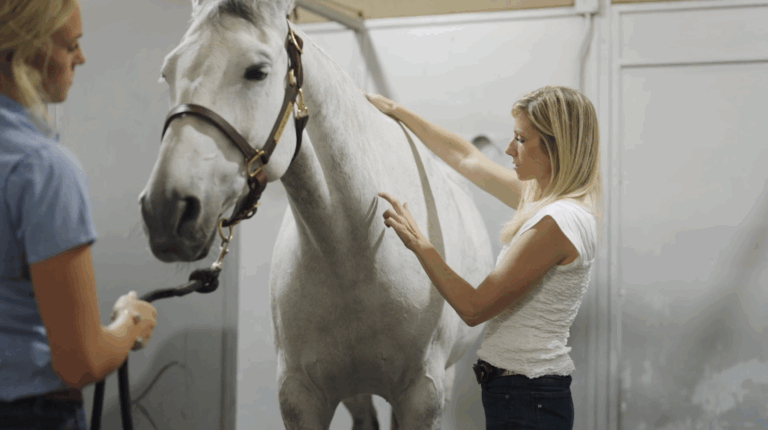
A relationship has been established between the ridden horse pain ethogram and performance, even in the absence of overt lameness. At the 2022 AAEP Convention, Sue Dyson, VetMB, PhD, presented a variety of studies demonstrating this connection.
Ridden Horse Pain Ethogram: 24 Behaviors
The ridden horse pain ethogram (RHpE) describes 24 behaviors. The majority of these are 10 times more likely to be identified in a lame horse, reported Dyson. Common examples include ears pinned back for ≥5 seconds, glazed stare or expression for ≥5 seconds, and the front of the head at least 10 degrees behind the vertical position for ≥10 seconds. Dyson explained that a horse demonstrating eight of 24 ethogram behaviors is likely experiencing musculoskeletal pain. The causal relationship between pain and behavior is further corroborated when RHpE behaviors diminish following diagnostic analgesia that abolishes lameness.
Evaluating Horses at Events
When examining highly trained horses at five-star events, Dyson suggested using a slightly lower total RHpE score of 7 as an indicator of possible influence on performance. One study of 35 horses at the Burley 2018 3-Day Event assessed horses for 10 minutes in a dressage warm-up. Horses were classified as non-lame, lame, or having a stiff, stilted gait at trot or canter. Elimination at cross-country occurred in 29% of horses with RHpE scores of <7 compared to 67% with RHpE scores >7.
At three other eventing venues, non-lame horses had a median RHpE score of 3 while those with gait abnormalities had median scores of 5 at trot or canter. The most common findings were the head behind the vertical for ≥10 seconds in 64%; repeated head tilt in 56%; mouth open with teeth separated for ≥10 seconds in 44%; intense stare for ≥5 seconds in 38%; and tail swishing in 38%. Horses with RHpE ≥7 (out of 24) had increased numbers of dressage penalties and were more likely to be eliminated or retired on the cross-country phase or finish in lower places. Of 172 starters, 63% with RHpE ≥7 failed to complete the cross-country phase compared to 31% with scores ≤7.
Consequences of Riding with Horse’s Head Behind the Vertical
Dyson described the consequences of riding with the horse’s head behind the vertical, as this reflects not only training methods but also musculoskeletal pain:
- Decreased engagement of muscles
- Decreased range of motion of thoraco-lumbar-sacral region
- Decreased epaxial muscle development
- Decreased hindlimb engagement and impulsion
- Increased risk of injury
Horses that start out compromised on the cross-country course require more effort to clear fences and are less able to adjust for problems.
Relationship Between RHpE and Competition Results
At a one-day eventing venue, 1,010 horses jumped fences of 90 or 100 cm, or 1.1 meters (approximately 3, 3.3, and 3.6 feet respectively). The horses were assessed during a five-minute dressage test. Horses placing in the top three spots had lower RHpE scores (median 2/24) than scores of other finishers (4/24). Even at low-level competition, there is a relationship between RHpE and performance, stated Dyson. There was a moderate positive correlation between dressage penalty scores and RHpE at all levels. Notably, these lower-level horses had a higher frequency of overt lameness or gait abnormalities at canter compared to five-star competitors.
At World Cup Grand Prix competitions with 147 evaluated, the median RHpE score was 3/24 with a range of 0-7. There was a high frequency (68%) of mouth opening with teeth separation for ≥10 seconds, head more than 10 degrees behind the vertical for ≥10 seconds in 56%, an intense stare ≥5 seconds in 30%, and repeated tail swishing in 29%. Tail swishing also occurred in synchrony with the rider’s spur taps in 36%. Dyson noted that judge scores seemed to reward horses with higher RHpE. For example, a horse with RHpE of 5 scored 82%.
Recommendation for Judges and Riders
With this in mind, Dyson recommended that judges should penalize incorrect performances and be more honest in their assessments, while riders and trainers should recognize what normal and correct movements look like. A horse tends to stiffen its back more when ridden from hand to leg rather than the correct method of leg to hand. Dyson stressed that rider skill can influence a horse’s gait quality and performance but cannot reduce the number of behaviors exhibited by a horse experiencing discomfort.
Veterinary involvement might help improve horse welfare and safety through performance health checks that include ridden exercise and RHpE scores. Warmup periods should include warm-up, not training, stressed Dyson, and riders should avoid asking for movements that the horse finds difficult, such as flying changes. She further noted that pain-free horses are more trainable and that riding a pain-free horse optimizes safety for horse and rider.








